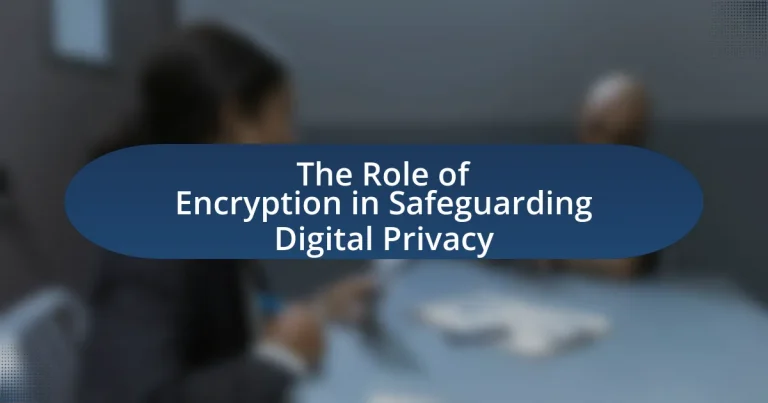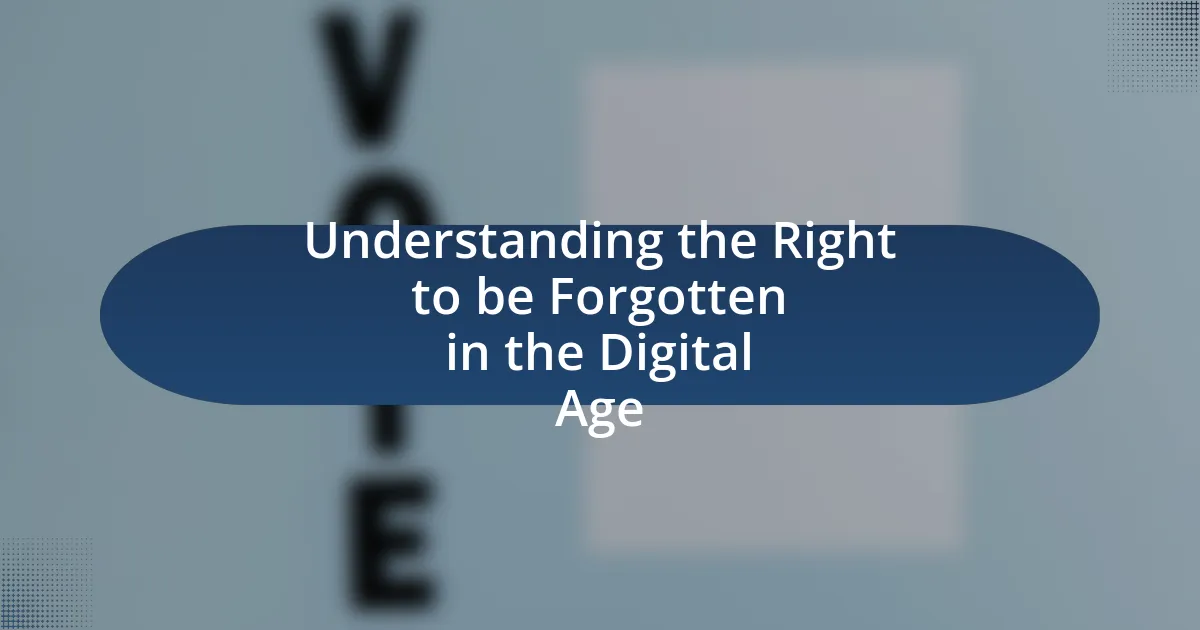Encryption is a critical technology for safeguarding digital privacy, transforming sensitive information into a coded format accessible only to authorized users. This article explores the various roles encryption plays in protecting personal data online, including its effectiveness against unauthorized access, data breaches, and cyber threats. It discusses different encryption methods, such as symmetric and asymmetric encryption, and highlights the importance of encryption in maintaining user trust and brand reputation. Additionally, the article addresses the challenges of implementing encryption, common misconceptions, and practical steps individuals can take to enhance their digital privacy through encryption tools and best practices.

What is the Role of Encryption in Safeguarding Digital Privacy?
Encryption plays a crucial role in safeguarding digital privacy by converting sensitive information into a coded format that can only be accessed by authorized users. This process protects data from unauthorized access, ensuring that personal information, financial details, and communications remain confidential. For instance, end-to-end encryption used in messaging apps like WhatsApp ensures that only the sender and recipient can read the messages, preventing interception by third parties. According to a 2020 report by the Electronic Frontier Foundation, encryption is essential for maintaining privacy in an era where data breaches and cyberattacks are increasingly common, highlighting its effectiveness in protecting user data from malicious actors.
How does encryption protect personal information online?
Encryption protects personal information online by converting data into a coded format that is unreadable without a decryption key. This process ensures that even if data is intercepted during transmission, it remains secure and inaccessible to unauthorized users. For instance, HTTPS, which employs encryption protocols like TLS, secures data exchanged between users and websites, safeguarding sensitive information such as passwords and credit card numbers. According to a study by the Ponemon Institute, 70% of organizations that implemented encryption reported a significant reduction in data breaches, highlighting its effectiveness in protecting personal information.
What types of data are most vulnerable without encryption?
Sensitive personal data, such as Social Security numbers, financial information, and health records, are most vulnerable without encryption. These types of data can be easily intercepted or accessed by unauthorized individuals, leading to identity theft, financial fraud, and privacy violations. For instance, a 2020 report by the Identity Theft Resource Center indicated that over 1,100 data breaches exposed more than 300 million sensitive records, highlighting the critical need for encryption to protect such information from cyber threats.
How does encryption prevent unauthorized access to data?
Encryption prevents unauthorized access to data by transforming readable information into an unreadable format using algorithms and keys. This process ensures that only individuals with the correct decryption key can access the original data, effectively safeguarding it from unauthorized users. For example, the Advanced Encryption Standard (AES) is widely used and recognized for its strength, as it employs a symmetric key encryption method that requires the same key for both encryption and decryption, making it difficult for attackers to gain access without the key.
Why is encryption essential in today’s digital landscape?
Encryption is essential in today’s digital landscape because it protects sensitive information from unauthorized access and cyber threats. With the increasing prevalence of data breaches, where over 4.1 billion records were exposed in 2019 alone, encryption serves as a critical defense mechanism. It ensures that even if data is intercepted, it remains unreadable without the proper decryption keys. Furthermore, encryption is vital for maintaining user trust, as 81% of consumers express concern about their online privacy. By safeguarding personal and financial information, encryption plays a crucial role in securing communications, transactions, and overall digital privacy.
What threats to digital privacy does encryption mitigate?
Encryption mitigates threats to digital privacy such as unauthorized access, data breaches, and eavesdropping. By converting information into a coded format, encryption ensures that only authorized users with the correct decryption key can access the original data. This process protects sensitive information from cybercriminals who may attempt to intercept communications or exploit vulnerabilities in systems. For instance, a study by the Ponemon Institute found that organizations using encryption experienced 50% fewer data breaches compared to those that did not implement such measures. This demonstrates the effectiveness of encryption in safeguarding personal and confidential information against various digital threats.
How has the rise of cybercrime influenced the need for encryption?
The rise of cybercrime has significantly increased the need for encryption as a critical measure for protecting sensitive data. As cybercriminal activities, such as data breaches and identity theft, have surged—evidenced by a 2021 report from Cybersecurity Ventures predicting that global cybercrime costs will reach $10.5 trillion annually by 2025—organizations and individuals have recognized encryption as essential for safeguarding information. Encryption transforms data into a secure format that is unreadable without the appropriate decryption key, thereby mitigating the risks posed by unauthorized access and ensuring confidentiality. This heightened awareness of cyber threats has led to widespread adoption of encryption technologies across various sectors, reinforcing its role in maintaining digital privacy.
What are the different types of encryption methods?
The different types of encryption methods include symmetric encryption, asymmetric encryption, and hashing. Symmetric encryption uses the same key for both encryption and decryption, making it efficient for large data sets; examples include AES (Advanced Encryption Standard) and DES (Data Encryption Standard). Asymmetric encryption employs a pair of keys—public and private—for secure communication, with RSA (Rivest-Shamir-Adleman) being a widely used algorithm. Hashing, while not encryption in the traditional sense, transforms data into a fixed-size string of characters, which is irreversible; common hashing algorithms include SHA-256 (Secure Hash Algorithm). These methods are foundational in securing digital communications and protecting sensitive information.
What is symmetric encryption and how does it work?
Symmetric encryption is a cryptographic method where the same key is used for both encryption and decryption of data. In this process, a plaintext message is transformed into ciphertext using a secret key, and the same key is required to revert the ciphertext back to its original plaintext form. This method relies on the confidentiality of the key; if the key remains secure, the encrypted data is protected from unauthorized access. Symmetric encryption algorithms, such as AES (Advanced Encryption Standard), are widely used due to their efficiency and speed in encrypting large amounts of data, making them suitable for various applications in safeguarding digital privacy.
What is asymmetric encryption and what are its advantages?
Asymmetric encryption is a cryptographic method that uses a pair of keys: a public key for encryption and a private key for decryption. This dual-key system enhances security by allowing users to share their public key openly while keeping their private key confidential. One significant advantage of asymmetric encryption is that it enables secure communication over insecure channels, as only the holder of the private key can decrypt messages encrypted with the corresponding public key. Additionally, it facilitates digital signatures, which authenticate the sender’s identity and ensure message integrity, thereby preventing tampering. These features make asymmetric encryption essential for safeguarding digital privacy in various applications, including secure email, online transactions, and data protection.
How does encryption impact user trust and confidence?
Encryption significantly enhances user trust and confidence by ensuring the confidentiality and integrity of their data. When users know that their sensitive information, such as personal details and financial transactions, is protected through encryption, they are more likely to engage with digital services. A study by the Ponemon Institute found that 70% of consumers are more likely to trust a company that uses encryption to protect their data. This trust is crucial in an era where data breaches and cyber threats are prevalent, as encryption acts as a safeguard against unauthorized access and data theft. Consequently, the implementation of strong encryption protocols not only fosters user confidence but also encourages greater participation in online activities, ultimately benefiting businesses and consumers alike.
Why do consumers prefer services that utilize encryption?
Consumers prefer services that utilize encryption primarily for enhanced security and privacy protection. Encryption safeguards sensitive information, such as personal data and financial transactions, from unauthorized access and cyber threats. According to a 2021 survey by the Pew Research Center, 81% of Americans feel that the potential risks of companies collecting their personal data outweigh the benefits. This statistic underscores the growing demand for secure services that prioritize user privacy through encryption. Additionally, services that implement encryption often comply with regulations like GDPR, which further assures consumers that their data is handled responsibly and securely.
How does encryption contribute to brand reputation?
Encryption enhances brand reputation by ensuring the security and privacy of customer data. When brands implement strong encryption practices, they demonstrate a commitment to protecting sensitive information, which builds trust among consumers. According to a 2021 survey by PwC, 79% of consumers expressed concern about how companies use their data, indicating that brands prioritizing encryption can differentiate themselves positively in a competitive market. Furthermore, high-profile data breaches often lead to significant reputational damage; for instance, the Equifax breach in 2017 resulted in a loss of consumer trust and a decline in stock value. Thus, effective encryption not only safeguards data but also reinforces a brand’s integrity and reliability in the eyes of consumers.
What are the challenges associated with implementing encryption?
Implementing encryption presents several challenges, including key management, performance overhead, and regulatory compliance. Key management is critical because securely generating, distributing, and storing encryption keys is complex; a 2021 study by the Ponemon Institute found that 60% of organizations struggle with key management. Performance overhead occurs as encryption can slow down system processes, impacting user experience; for instance, encrypting large datasets can significantly increase processing time. Regulatory compliance adds another layer of difficulty, as organizations must navigate varying laws and standards, such as GDPR in Europe, which mandates specific encryption practices to protect personal data. These challenges highlight the multifaceted nature of implementing encryption effectively.
What are common misconceptions about encryption?
Common misconceptions about encryption include the belief that it guarantees complete security, that it is only necessary for sensitive data, and that it is too complex for average users. Encryption does not provide absolute security; vulnerabilities can exist in implementation or user practices, as evidenced by high-profile breaches despite encryption being in place. Additionally, encryption is essential for all data types, not just sensitive information, as even seemingly innocuous data can be exploited. Lastly, advancements in user-friendly encryption tools have made it accessible, countering the notion that only experts can effectively use encryption.
How can organizations overcome barriers to encryption adoption?
Organizations can overcome barriers to encryption adoption by implementing comprehensive training programs and fostering a culture of security awareness. Training equips employees with the necessary skills to understand and utilize encryption technologies effectively, addressing knowledge gaps that often hinder adoption. According to a study by the Ponemon Institute, organizations that invest in security awareness training experience a 70% reduction in security incidents. Additionally, leadership commitment to encryption as a priority can drive organizational change, ensuring that resources are allocated for the necessary tools and support. By addressing both the technical and human factors, organizations can successfully navigate the challenges associated with encryption adoption.
How can individuals enhance their digital privacy through encryption?
Individuals can enhance their digital privacy through encryption by using encryption tools to secure their communications and data. By employing end-to-end encryption in messaging apps like Signal or WhatsApp, individuals ensure that only the intended recipients can read their messages, preventing unauthorized access. Additionally, utilizing encryption software for files and emails, such as VeraCrypt or PGP, protects sensitive information from being intercepted or accessed by third parties. According to a 2021 report by the Electronic Frontier Foundation, encryption significantly reduces the risk of data breaches and unauthorized surveillance, highlighting its effectiveness in safeguarding personal privacy online.
What tools and software are recommended for personal encryption?
Recommended tools and software for personal encryption include VeraCrypt, BitLocker, and AxCrypt. VeraCrypt is an open-source disk encryption software that provides strong security through advanced encryption algorithms, making it suitable for encrypting files and entire drives. BitLocker, integrated into Windows, offers full disk encryption and is user-friendly for Windows users, ensuring data protection without additional software. AxCrypt is designed for individual file encryption, providing a simple interface and strong AES-128 and AES-256 encryption options. These tools are widely recognized for their effectiveness in safeguarding digital privacy by protecting sensitive information from unauthorized access.
What best practices should users follow to ensure effective encryption?
To ensure effective encryption, users should implement strong, unique passwords and utilize up-to-date encryption algorithms. Strong passwords enhance security by making unauthorized access more difficult, while using modern encryption standards, such as AES-256, ensures that data remains secure against evolving threats. Additionally, users should regularly update their software to protect against vulnerabilities, as outdated systems can be exploited. Employing two-factor authentication adds an extra layer of security, further safeguarding encrypted data. These practices are supported by cybersecurity guidelines from organizations like the National Institute of Standards and Technology (NIST), which emphasizes the importance of strong encryption and regular updates in maintaining digital privacy.
What future trends in encryption should we be aware of?
Future trends in encryption include the rise of quantum encryption, homomorphic encryption, and the adoption of post-quantum cryptography. Quantum encryption utilizes the principles of quantum mechanics to create secure communication channels that are theoretically immune to eavesdropping. Homomorphic encryption allows computations to be performed on encrypted data without needing to decrypt it, enhancing privacy in cloud computing and data analysis. Post-quantum cryptography is being developed to protect against potential threats posed by quantum computers, which could break traditional encryption methods. These trends are driven by the increasing need for robust security measures in response to evolving cyber threats and the growing importance of data privacy regulations.
How is quantum computing expected to affect encryption methods?
Quantum computing is expected to significantly undermine traditional encryption methods, particularly those based on mathematical problems like factoring large integers and solving discrete logarithms. This is primarily due to quantum algorithms, such as Shor’s algorithm, which can efficiently break widely used encryption standards like RSA and ECC. As a result, the security of sensitive data could be compromised, necessitating the development of quantum-resistant encryption techniques to safeguard digital privacy.
What innovations are emerging in encryption technology?
Emerging innovations in encryption technology include quantum encryption, homomorphic encryption, and advanced symmetric encryption algorithms. Quantum encryption utilizes the principles of quantum mechanics to create secure communication channels that are theoretically immune to eavesdropping, as demonstrated by the development of quantum key distribution (QKD) protocols. Homomorphic encryption allows computations to be performed on encrypted data without needing to decrypt it first, which enhances privacy in cloud computing environments, as evidenced by research from IBM on fully homomorphic encryption. Additionally, advancements in symmetric encryption algorithms, such as AES-256, continue to improve security and efficiency, with ongoing research into post-quantum cryptography to prepare for future threats posed by quantum computing.
What practical steps can individuals take to safeguard their digital privacy with encryption?
Individuals can safeguard their digital privacy with encryption by using strong encryption tools for their communications and data storage. Implementing end-to-end encryption in messaging apps, such as Signal or WhatsApp, ensures that only the sender and recipient can read the messages, protecting against interception. Additionally, utilizing full-disk encryption on devices, like BitLocker for Windows or FileVault for macOS, secures data at rest, making it inaccessible without proper authentication.
Regularly updating software and encryption protocols is crucial, as vulnerabilities can be exploited by attackers. For instance, using up-to-date versions of TLS (Transport Layer Security) for web browsing protects data in transit. Furthermore, individuals should consider using a Virtual Private Network (VPN) that employs strong encryption standards to secure their internet connection, preventing eavesdropping on online activities.
These steps are supported by the fact that encrypted communications significantly reduce the risk of data breaches and unauthorized access, as highlighted in studies showing that encryption can deter cybercriminals and protect sensitive information effectively.





